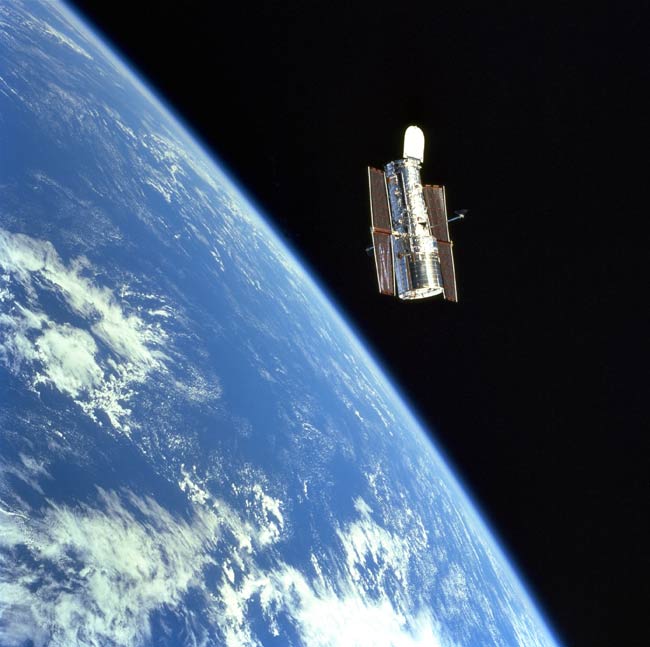NASA to Begin Hubble Space Telescope Fix

NASAengineers hope to begin reviving the ailing Hubble Space Telescope Wednesday witha days-long switch to a backup system after a hardware failure cut off itsability to transmit images back to Earth last month.
Theswitch will take at least two days, with engineers working around the clock in Hubble?soperations center at NASA?s Goddard Space Flight Center to rouse the backupsystem from nearly two decades of slumber. NASA is confident the fix will resuscitateHubble?s science instruments by Friday, but there is always thechance of an unexpected glitch during the process, Hubble managers said.
?Itis obviously a possibility that things will not come up,? Art Whipple, chief ofNASA?s Hubble systems management office at Goddard in Greenbelt, Md., toldreporters in a Tuesday teleconference.
ButNASA?s history of booting up systems in space after years of inactivity isencouraging, and weeks of testing and analysis on Earth show Hubble to be readyfor reactivation, he added.
?Wehave very good confidence that this will work,? Whipple said.
Hubblehas been unable to send the majority of its science data and images toEarth since Sept. 27, when a data relay channel failed after 18 years in action.
Thefailed channel, known as Side A of a device called a Control Unit/Science DataFormatter in Hubble?s Data Handling Unit, has been the primary path for thetelescope?s observations since it launched in April 1990. Hubble does have abackup channel, Side B. But that channel has sat dormant since before thetelescope launched.
Get the Space.com Newsletter
Breaking space news, the latest updates on rocket launches, skywatching events and more!
Switchingthe space telescope?s systems over to that path requires the tricky transitionof six other backup systems, five of which have also been powered off since1990, Hubble managers have said. Engineers have spent the past few weeksexhaustively reviewing the lengthy process in the hope of ensuring a successfulreactivation.
Asidefrom the failed relay channel, the space telescope is in good health. Oneinstrument - a fine guidance sensor that can communicate with Earthindependently - is still able to conduct astrometry observations by tracking targetstars, Hubble managers said.
Iffor some reason, Hubble?s switch to Side B fails, the telescope could continueits astrometry studies until a shuttle repair mission slated for next year,said John Morse, director of NASA?s astrophysics division.
RebootingHubble
Ateam of up to 50 Hubble engineers and flight controllers are expected to reportfor duty between 6:00-7:00 a.m. EDT (1000-1100 GMT) to begin the spacetelescope?s resurrection. But the bulk of the repair comes around midday, whenthey will bring direct Hubble to boot up its Side B backup relay channel.
?Themost critical part of the commanding will happen between 8:30 a.m. and 11:00a.m. Eastern time,? Whipple said. ?We expect the full flow of science to resumeFriday morning.?
Afew dozen computer commands should handle Hubble?s backup system activation,though it will take about 200 or so computer commands to move the telescope inand out of a protective ?safe mode? to make the switch, said Whipple. He likenedthe process as similar to an IT professional setting up routers for an officecomputer network.
Someinstruments could begin beaming down data as early as late Thursday evening, Whippleadded.
Therecent Hubble failure prompted NASA to hold off on launching the space shuttleAtlantis and seven astronauts to the space telescope this month on the fifthand final service call on the orbital observatory. The mission has been pushedto no earlier than February 2009, with engineers at Goddard hoping to add aspare data formatter unit to replace the broken Side A channel.
?The[replacement] unit will start testing next week,? Whipple said, adding that aseries of stress tests to check the spare?s health will likely last for months.
But,he added, there is ample room in the shuttle Atlantis? cargo bay to hold thespare, and weight margins to launch the unit to Hubble next year.
Shuttlemission managers are still studying how adding the relatively straightforwardrepair tasks will impact the already packed servicing flight schedule, Morseadded.
Commandedby veteran spaceflyer Scott Altman, Atlantis?Hubble servicing crew plans to perform five back-to-back spacewalks to addnew cameras, replace old batteries and gyroscopes, add docking equipment andupgrade the telescope?s guidance system. The astronauts will also attempt tofix a vital spectrometer and Hubble?s main survey camera ? equipment neverdesigned to be repaired in orbit.
?Perhapsone of the ironies here is how much effort will go into bring the Hubble telescopeback to its normal productivity,? Morse said. ?And that?s everyone?s goal is tosee wonderful science coming back from the telescope again.?
- New Video - Hubble Space Telescope Mission Control
- Video - Hubble's Last Service Call
- Hubble Images - When Galaxies Collide
Join our Space Forums to keep talking space on the latest missions, night sky and more! And if you have a news tip, correction or comment, let us know at: community@space.com.

Tariq is the Editor-in-Chief of Space.com and joined the team in 2001, first as an intern and staff writer, and later as an editor. He covers human spaceflight, exploration and space science, as well as skywatching and entertainment. He became Space.com's Managing Editor in 2009 and Editor-in-Chief in 2019. Before joining Space.com, Tariq was a staff reporter for The Los Angeles Times covering education and city beats in La Habra, Fullerton and Huntington Beach. In October 2022, Tariq received the Harry Kolcum Award for excellence in space reporting from the National Space Club Florida Committee. He is also an Eagle Scout (yes, he has the Space Exploration merit badge) and went to Space Camp four times as a kid and a fifth time as an adult. He has journalism degrees from the University of Southern California and New York University. You can find Tariq at Space.com and as the co-host to the This Week In Space podcast with space historian Rod Pyle on the TWiT network. To see his latest project, you can follow Tariq on Twitter @tariqjmalik.









